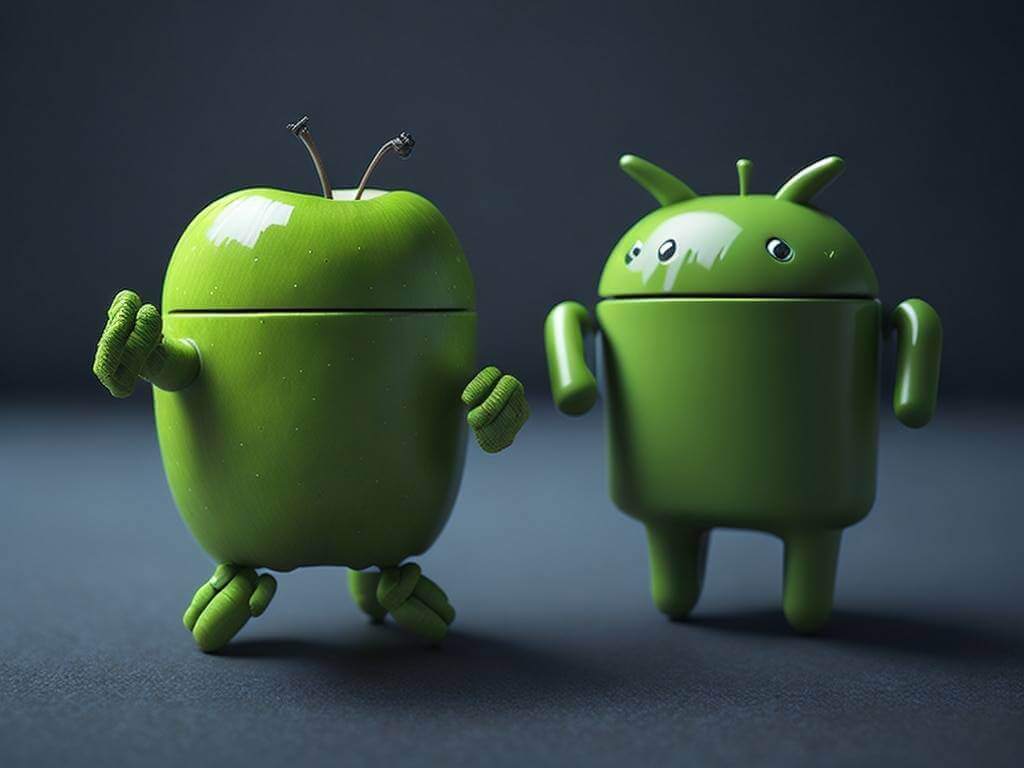The Battle of iOS vs Android
In the world of smartphones, two operating systems dominate the market: iOS and Android. iOS, developed by Apple, is exclusive to iPhones and iPads, while Android, developed by Google, is used by a wide range of manufacturers such as Samsung, Huawei and Google’s own Pixel devices. Both operating systems have their own unique features and design philosophies, but the ultimate goal is to provide users with the best possible user experience.
The user experience is a crucial aspect of any operating system. It encompasses everything from the design and layout of the user interface to the performance and functionality of the device. A good user experience can make a device enjoyable and easy to use, while a poor user experience can lead to frustration and dissatisfaction. With so many options available in the market, it’s important to compare iOS and Android to determine which operating system offers the best user experience overall.
User Interface: Which OS is More User-Friendly?
One of the first things that users interact with when using a smartphone is the user interface. The design and layout of the user interface can greatly impact the overall user experience. When it comes to iOS and Android, both operating systems have their own unique design philosophies.
iOS is known for its clean and minimalist design. The interface is simple and intuitive, with a focus on ease of use. The home screen consists of a grid of icons, which can be rearranged and organized into folders. The control center, accessed by swiping up from the bottom of the screen, provides quick access to commonly used settings and features. Overall, iOS offers a user-friendly interface that is easy to navigate and understand.
On the other hand, Android offers a more customizable user interface. The home screen can be personalized with widgets, shortcuts and live wallpapers. Users can also choose from a variety of launchers to completely change the look and feel of their device. While this level of customization can be appealing to some users, it can also be overwhelming for others. Android’s interface may not be as intuitive as iOS, but it offers more flexibility and personalization options.
Customization: Which OS Offers More Personalization Options?
When it comes to personalization, Android takes the lead. Android allows users to customize almost every aspect of their device, from the home screen to the notification panel. Users can choose from a wide range of widgets, wallpapers and icon packs to personalize their device to their liking. Additionally, Android offers the ability to install third-party launchers, which can completely change the look and feel of the device.
On the other hand, iOS has limited customization options. Users can change the wallpaper and rearrange icons on the home screen, but that’s about it. Apple has always prioritized simplicity and consistency over customization, which can be a drawback for users who like to personalize their devices.
App Store: Which OS Has Better App Selection and Quality?
The app store is another important aspect of the user experience. Both iOS and Android have their own app stores, offering a wide range of apps and games. However, there are some key differences between the two.
iOS is known for its curated app store, which ensures that all apps go through a strict review process before being made available to users. This results in a higher quality of apps overall, with fewer instances of malware or low-quality apps. Additionally, developers often prioritize iOS when it comes to releasing new apps and updates, so iOS users tend to have access to the latest apps and features first.
On the other hand, Android’s app store, Google Play Store, offers a larger selection of apps and games. This is partly due to the open nature of the Android platform, which allows developers to easily publish their apps. While this means that there are more options available for Android users, it also means that there is a higher chance of encountering low-quality or malicious apps.
Security: Which OS is More Secure?
Security is a major concern for smartphone users, as our devices contain a wealth of personal information. When it comes to security, iOS has a reputation for being more secure than Android. This is partly due to Apple’s strict control over the hardware and software of its devices. Additionally, iOS has built-in security features such as Touch ID and Face ID, which provide secure authentication methods.
Android, on the other hand, has had a history of security vulnerabilities. This is partly due to the open nature of the platform, which makes it more susceptible to malware and other security threats. However, Google has made significant improvements to the security of Android in recent years, with features such as Google Play Protect and regular security updates. While Android may not be as secure as iOS, it is still a viable option for users who prioritize security.
Battery Life: Which OS Offers Better Battery Performance?
Battery life is a crucial aspect of the user experience, as no one wants to constantly worry about running out of battery. When it comes to battery performance, both iOS and Android have their own strengths and weaknesses.
iOS is known for its efficient battery management. Apple’s hardware and software integration allows for optimized power consumption, resulting in longer battery life. Additionally, iOS offers features such as Low Power Mode, which reduces background activity and extends battery life even further.
On the other hand, Android devices vary greatly in terms of battery performance. Some Android devices offer excellent battery life, while others may struggle to last a full day. This is partly due to the wide range of hardware and software configurations available on Android devices. However, Android does offer features such as Battery Saver mode, which can help extend battery life when needed.
Integration: Which OS Integrates Better with Other Devices and Services?
Integration with other devices and services is becoming increasingly important in today’s connected world. Both iOS and Android offer integration with a wide range of devices and services, but there are some key differences.
iOS is known for its seamless integration with other Apple devices and services. For example, users can easily sync their iPhone with their Mac, iPad and Apple Watch, allowing for a seamless experience across all devices. Additionally, iOS offers integration with Apple’s ecosystem of services, such as iCloud, iMessage and Apple Music.
On the other hand, Android offers integration with a wide range of devices and services as well. Android devices can be easily connected to smart home devices, wearables and other accessories. Additionally, Android offers integration with Google’s ecosystem of services, such as Google Drive, Google Photos and Google Assistant.
Updates: Which OS Offers More Timely and Consistent Updates?
Software updates are crucial for the security and performance of a device. When it comes to updates, iOS has a clear advantage over Android. Apple releases regular updates for iOS, providing users with the latest features and security patches. Additionally, iOS updates are available to all supported devices at the same time, ensuring a consistent experience across the ecosystem.
On the other hand, Android updates can be fragmented and inconsistent. This is partly due to the wide range of manufacturers and devices running on the Android platform. Manufacturers often customize the Android software to suit their own needs, which can result in delays in receiving updates. Additionally, carriers may also delay the release of updates. However, Google has made efforts to improve the update process with initiatives such as Project Treble, which aims to make it easier for manufacturers to release updates.
Performance: Which OS Runs More Smoothly and Efficiently?
Performance is a crucial aspect of the user experience. When it comes to performance, both iOS and Android have their own strengths and weaknesses.
iOS is known for its smooth and responsive performance. Apple’s hardware and software integration allows for optimized performance, resulting in fast and efficient operation. Additionally, iOS is known for its app optimization, with developers often prioritizing iOS when it comes to performance and features.
On the other hand, Android devices vary greatly in terms of performance. Some Android devices offer excellent performance, while others may struggle with lag and slowdowns. This is partly due to the wide range of hardware and software configurations available on Android devices. However, Google has made efforts to improve the performance of Android with initiatives such as Project Butter and Project Mainline.
Accessibility: Which OS Offers Better Accessibility Features?
Accessibility features are crucial for users with disabilities or special needs. When it comes to accessibility, both iOS and Android offer a range of features to accommodate different users.
iOS is known for its comprehensive accessibility features. Apple has made significant efforts to ensure that its devices are accessible to all users. iOS offers features such as VoiceOver, which provides spoken descriptions of onscreen elements and AssistiveTouch, which allows users to control their device with gestures instead of physical buttons. Additionally, iOS offers support for hearing aids, braille displays and other assistive technologies.
On the other hand, Android also offers a range of accessibility features. Android devices can be customized with features such as TalkBack, which provides spoken feedback for users with visual impairments and Switch Access, which allows users to control their device with switches or other assistive devices. Additionally, Android offers support for hearing aids, braille displays and other assistive technologies.
Price: Which OS Offers Better Value for Money?
Price is an important factor to consider when choosing a smartphone. When it comes to price, Android devices generally offer better value for money compared to iPhones. Android devices come in a wide range of price points, from budget-friendly options to high-end flagship devices. This allows users to choose a device that fits their budget and needs.
On the other hand, iPhones tend to be more expensive compared to Android devices. Apple’s devices are known for their premium build quality and performance, but this comes at a higher price. However, Apple does offer more affordable options such as the iPhone SE, which provides a good balance of performance and price.
Conclusion: Which OS Offers the Best User Experience Overall?
After comparing iOS and Android in various aspects of the user experience, it’s clear that both operating systems have their own strengths and weaknesses. iOS offers a user-friendly interface, excellent app selection and quality and a secure and optimized experience. On the other hand, Android offers more customization options, better integration with other devices and services and a wider range of price points.
Ultimately, the best operating system for you will depend on your personal preferences and needs. If you value simplicity, security and a curated app store, iOS may be the best choice for you. On the other hand, if you value customization, flexibility and a wide range of options, Android may be the better option. It’s important to consider your priorities and do your research before making a decision

Bhetaludu has fresh tech news and cool travel tales. He covers gadgets and faraway places. His blog is for tech fans and those who love to explore.





